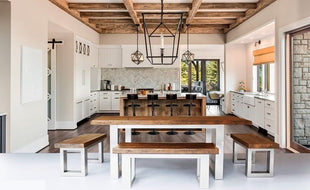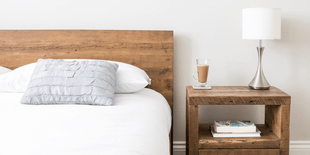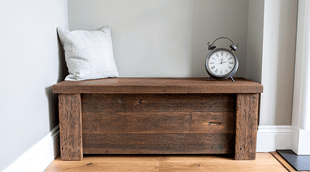 Something as simple as a lick of paint can give anything a new lease of life and it’s really easy to transform almost anything with paint. When it comes to wooden furniture though the last thing you want to do is damage it as it’s likely to have been pretty expensive when it was first purchased. In order to avoid causing irreparable damage it’s essential to follow the appropriate steps that will ensure you end the process with a piece of furniture that is, for all intents and purposes, brand new without causing any damage to the original piece at all.
Sanding is the place to start when it comes to painting or repainting wooden furniture. Before you pick up a paint brush it’s essential to remove any paint or varnish that is already covering the surface of the furniture by sanding the piece until it’s clear. Although you can sand the piece down by hand if you wanted to it will take a lot of time, patience, energy and strength so it’s much easier to use a mechanical sander – like an orbital sander for example – however, smaller machines also do a great job. Once you’ve removed the majority of the finish with a mechanical sander you’ll have to manually sand any hard to reach areas with some sand paper. Sanding is an essential process if you want the primer and paint coating to stick to the furniture.
Once you’ve sanded the piece it’s essential to remove all of the dust that’s gathered on its surface. In order to make sure you’ve removed all of the dust successfully wiping the surface with a damp cloth and then vacuuming it often does the trick. If you fail to remove the dust then the primer and new coat of paint are unlikely to stick and even if they do the coating will be ruined by flecks of dust running through it.
There’s one more coat that’s required before painting and that’s a layer of primer which will protect the wood. In order to prime effectively it’s essential to apply a few thin coats rather than a single thick coat. Primers come in a choice of grey and white and the colour you choose depends entirely on the colour you intend to paint your furniture once it’s dry. If your final colour will be pretty dark then it’s a good idea to use a grey primer whereas you’ll be using a light paint colour then white will be much easier to cover. A number of very thin coats is the key to a good layer of primer, you should barely be able to see the first layer once it’s dried and after that you should build it up slowly, allowing each layer to dry thoroughly before applying another.
Finally it’s time to paint. The ultimate aim is to achieve a smooth finish which is much easier if you have a paint that has a thinner consistency than ordinary paint. Before you start it’s essential to mix the paint well and it’s a good idea to use a bristled brush rather than a foam brush too as it creates a much better effect. Just as you did with the primer, a thin first coat is a good idea if you want to create an even finish. A few thin coats as opposed to one thick coat will also make the finish much more durable. Remember if you want the finish to look even – this is especially important on flat sections for example the top of a chest of drawers – then long strokes that span the length of the piece will create a much more even gloss than a stroke that only goes half way.
Once you’ve been successful with one piece you’ll see what a great difference a coat of paint can make and you won’t be able to stop yourself from renovating even more.
Something as simple as a lick of paint can give anything a new lease of life and it’s really easy to transform almost anything with paint. When it comes to wooden furniture though the last thing you want to do is damage it as it’s likely to have been pretty expensive when it was first purchased. In order to avoid causing irreparable damage it’s essential to follow the appropriate steps that will ensure you end the process with a piece of furniture that is, for all intents and purposes, brand new without causing any damage to the original piece at all.
Sanding is the place to start when it comes to painting or repainting wooden furniture. Before you pick up a paint brush it’s essential to remove any paint or varnish that is already covering the surface of the furniture by sanding the piece until it’s clear. Although you can sand the piece down by hand if you wanted to it will take a lot of time, patience, energy and strength so it’s much easier to use a mechanical sander – like an orbital sander for example – however, smaller machines also do a great job. Once you’ve removed the majority of the finish with a mechanical sander you’ll have to manually sand any hard to reach areas with some sand paper. Sanding is an essential process if you want the primer and paint coating to stick to the furniture.
Once you’ve sanded the piece it’s essential to remove all of the dust that’s gathered on its surface. In order to make sure you’ve removed all of the dust successfully wiping the surface with a damp cloth and then vacuuming it often does the trick. If you fail to remove the dust then the primer and new coat of paint are unlikely to stick and even if they do the coating will be ruined by flecks of dust running through it.
There’s one more coat that’s required before painting and that’s a layer of primer which will protect the wood. In order to prime effectively it’s essential to apply a few thin coats rather than a single thick coat. Primers come in a choice of grey and white and the colour you choose depends entirely on the colour you intend to paint your furniture once it’s dry. If your final colour will be pretty dark then it’s a good idea to use a grey primer whereas you’ll be using a light paint colour then white will be much easier to cover. A number of very thin coats is the key to a good layer of primer, you should barely be able to see the first layer once it’s dried and after that you should build it up slowly, allowing each layer to dry thoroughly before applying another.
Finally it’s time to paint. The ultimate aim is to achieve a smooth finish which is much easier if you have a paint that has a thinner consistency than ordinary paint. Before you start it’s essential to mix the paint well and it’s a good idea to use a bristled brush rather than a foam brush too as it creates a much better effect. Just as you did with the primer, a thin first coat is a good idea if you want to create an even finish. A few thin coats as opposed to one thick coat will also make the finish much more durable. Remember if you want the finish to look even – this is especially important on flat sections for example the top of a chest of drawers – then long strokes that span the length of the piece will create a much more even gloss than a stroke that only goes half way.
Once you’ve been successful with one piece you’ll see what a great difference a coat of paint can make and you won’t be able to stop yourself from renovating even more.
How to paint wooden furniture
 Something as simple as a lick of paint can give anything a new lease of life and it’s really easy to transform almost anything with paint. When it comes to wooden furniture though the last thing you want to do is damage it as it’s likely to have been pretty expensive when it was first purchased. In order to avoid causing irreparable damage it’s essential to follow the appropriate steps that will ensure you end the process with a piece of furniture that is, for all intents and purposes, brand new without causing any damage to the original piece at all.
Sanding is the place to start when it comes to painting or repainting wooden furniture. Before you pick up a paint brush it’s essential to remove any paint or varnish that is already covering the surface of the furniture by sanding the piece until it’s clear. Although you can sand the piece down by hand if you wanted to it will take a lot of time, patience, energy and strength so it’s much easier to use a mechanical sander – like an orbital sander for example – however, smaller machines also do a great job. Once you’ve removed the majority of the finish with a mechanical sander you’ll have to manually sand any hard to reach areas with some sand paper. Sanding is an essential process if you want the primer and paint coating to stick to the furniture.
Once you’ve sanded the piece it’s essential to remove all of the dust that’s gathered on its surface. In order to make sure you’ve removed all of the dust successfully wiping the surface with a damp cloth and then vacuuming it often does the trick. If you fail to remove the dust then the primer and new coat of paint are unlikely to stick and even if they do the coating will be ruined by flecks of dust running through it.
There’s one more coat that’s required before painting and that’s a layer of primer which will protect the wood. In order to prime effectively it’s essential to apply a few thin coats rather than a single thick coat. Primers come in a choice of grey and white and the colour you choose depends entirely on the colour you intend to paint your furniture once it’s dry. If your final colour will be pretty dark then it’s a good idea to use a grey primer whereas you’ll be using a light paint colour then white will be much easier to cover. A number of very thin coats is the key to a good layer of primer, you should barely be able to see the first layer once it’s dried and after that you should build it up slowly, allowing each layer to dry thoroughly before applying another.
Finally it’s time to paint. The ultimate aim is to achieve a smooth finish which is much easier if you have a paint that has a thinner consistency than ordinary paint. Before you start it’s essential to mix the paint well and it’s a good idea to use a bristled brush rather than a foam brush too as it creates a much better effect. Just as you did with the primer, a thin first coat is a good idea if you want to create an even finish. A few thin coats as opposed to one thick coat will also make the finish much more durable. Remember if you want the finish to look even – this is especially important on flat sections for example the top of a chest of drawers – then long strokes that span the length of the piece will create a much more even gloss than a stroke that only goes half way.
Once you’ve been successful with one piece you’ll see what a great difference a coat of paint can make and you won’t be able to stop yourself from renovating even more.
Something as simple as a lick of paint can give anything a new lease of life and it’s really easy to transform almost anything with paint. When it comes to wooden furniture though the last thing you want to do is damage it as it’s likely to have been pretty expensive when it was first purchased. In order to avoid causing irreparable damage it’s essential to follow the appropriate steps that will ensure you end the process with a piece of furniture that is, for all intents and purposes, brand new without causing any damage to the original piece at all.
Sanding is the place to start when it comes to painting or repainting wooden furniture. Before you pick up a paint brush it’s essential to remove any paint or varnish that is already covering the surface of the furniture by sanding the piece until it’s clear. Although you can sand the piece down by hand if you wanted to it will take a lot of time, patience, energy and strength so it’s much easier to use a mechanical sander – like an orbital sander for example – however, smaller machines also do a great job. Once you’ve removed the majority of the finish with a mechanical sander you’ll have to manually sand any hard to reach areas with some sand paper. Sanding is an essential process if you want the primer and paint coating to stick to the furniture.
Once you’ve sanded the piece it’s essential to remove all of the dust that’s gathered on its surface. In order to make sure you’ve removed all of the dust successfully wiping the surface with a damp cloth and then vacuuming it often does the trick. If you fail to remove the dust then the primer and new coat of paint are unlikely to stick and even if they do the coating will be ruined by flecks of dust running through it.
There’s one more coat that’s required before painting and that’s a layer of primer which will protect the wood. In order to prime effectively it’s essential to apply a few thin coats rather than a single thick coat. Primers come in a choice of grey and white and the colour you choose depends entirely on the colour you intend to paint your furniture once it’s dry. If your final colour will be pretty dark then it’s a good idea to use a grey primer whereas you’ll be using a light paint colour then white will be much easier to cover. A number of very thin coats is the key to a good layer of primer, you should barely be able to see the first layer once it’s dried and after that you should build it up slowly, allowing each layer to dry thoroughly before applying another.
Finally it’s time to paint. The ultimate aim is to achieve a smooth finish which is much easier if you have a paint that has a thinner consistency than ordinary paint. Before you start it’s essential to mix the paint well and it’s a good idea to use a bristled brush rather than a foam brush too as it creates a much better effect. Just as you did with the primer, a thin first coat is a good idea if you want to create an even finish. A few thin coats as opposed to one thick coat will also make the finish much more durable. Remember if you want the finish to look even – this is especially important on flat sections for example the top of a chest of drawers – then long strokes that span the length of the piece will create a much more even gloss than a stroke that only goes half way.
Once you’ve been successful with one piece you’ll see what a great difference a coat of paint can make and you won’t be able to stop yourself from renovating even more.







